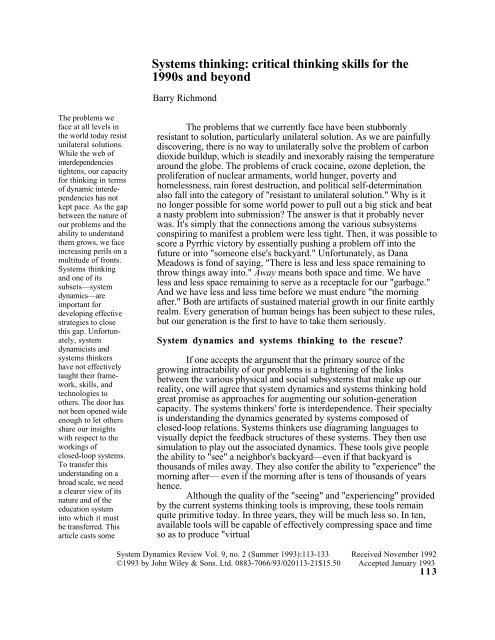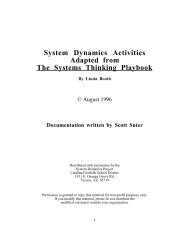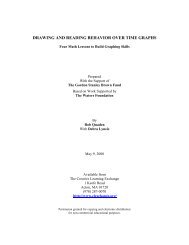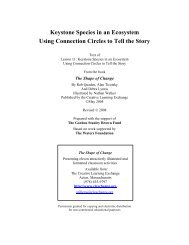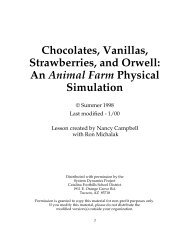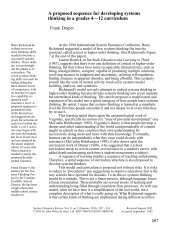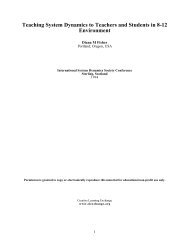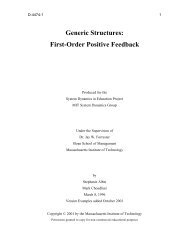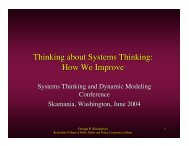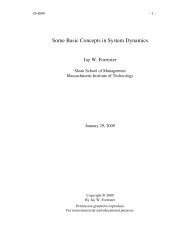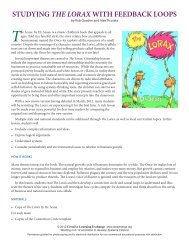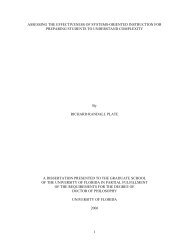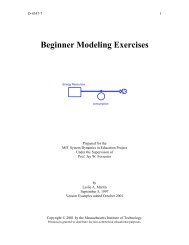Systems thinking: critical thinking skills for the 1990s and beyond
Systems thinking: critical thinking skills for the 1990s and beyond
Systems thinking: critical thinking skills for the 1990s and beyond
- No tags were found...
You also want an ePaper? Increase the reach of your titles
YUMPU automatically turns print PDFs into web optimized ePapers that Google loves.
<strong>Systems</strong> <strong>thinking</strong>: <strong>critical</strong> <strong>thinking</strong> <strong>skills</strong> <strong>for</strong> <strong>the</strong><strong>1990s</strong> <strong>and</strong> <strong>beyond</strong>Barry RichmondThe problems weface at all levels in<strong>the</strong> world today resistunilateral solutions.While <strong>the</strong> web ofinterdependenciestightens, our capacity<strong>for</strong> <strong>thinking</strong> in termsof dynamic interdependencieshas notkept pace. As <strong>the</strong> gapbetween <strong>the</strong> nature ofour problems <strong>and</strong> <strong>the</strong>ability to underst<strong>and</strong><strong>the</strong>m grows, we faceincreasing perils on amultitude of fronts.<strong>Systems</strong> <strong>thinking</strong><strong>and</strong> one of itssubsets—systemdynamics—areimportant <strong>for</strong>developing effectivestrategies to closethis gap. Un<strong>for</strong>tunately,systemdynamicists <strong>and</strong>systems thinkershave not effectivelytaught <strong>the</strong>ir framework,<strong>skills</strong>, <strong>and</strong>technologies too<strong>the</strong>rs. The door hasnot been opened wideenough to let o<strong>the</strong>rsshare our insightswith respect to <strong>the</strong>workings ofclosed-loop systems.To transfer thisunderst<strong>and</strong>ing on abroad scale, we needa clearer view of itsnature <strong>and</strong> of <strong>the</strong>education systeminto which it mustbe transferred. Thisarticle casts someThe problems that we currently face have been stubbornlyresistant to solution, particularly unilateral solution. As we are painfullydiscovering, <strong>the</strong>re is no way to unilaterally solve <strong>the</strong> problem of carbondioxide buildup, which is steadily <strong>and</strong> inexorably raising <strong>the</strong> temperaturearound <strong>the</strong> globe. The problems of crack cocaine, ozone depletion, <strong>the</strong>proliferation of nuclear armaments, world hunger, poverty <strong>and</strong>homelessness, rain <strong>for</strong>est destruction, <strong>and</strong> political self-determinationalso fall into <strong>the</strong> category of "resistant to unilateral solution." Why is itno longer possible <strong>for</strong> some world power to pull out a big stick <strong>and</strong> beata nasty problem into submission? The answer is that it probably neverwas. It's simply that <strong>the</strong> connections among <strong>the</strong> various subsystemsconspiring to manifest a problem were less tight. Then, it was possible toscore a Pyrrhic victory by essentially pushing a problem off into <strong>the</strong>future or into "someone else's backyard." Un<strong>for</strong>tunately, as DanaMeadows is fond of saying, "There is less <strong>and</strong> less space remaining tothrow things away into." Away means both space <strong>and</strong> time. We haveless <strong>and</strong> less space remaining to serve as a receptacle <strong>for</strong> our "garbage."And we have less <strong>and</strong> less time be<strong>for</strong>e we must endure "<strong>the</strong> morningafter." Both are artifacts of sustained material growth in our finite earthlyrealm. Every generation of human beings has been subject to <strong>the</strong>se rules,but our generation is <strong>the</strong> first to have to take <strong>the</strong>m seriously.System dynamics <strong>and</strong> systems <strong>thinking</strong> to <strong>the</strong> rescue?If one accepts <strong>the</strong> argument that <strong>the</strong> primary source of <strong>the</strong>growing intractability of our problems is a tightening of <strong>the</strong> linksbetween <strong>the</strong> various physical <strong>and</strong> social subsystems that make up ourreality, one will agree that system dynamics <strong>and</strong> systems <strong>thinking</strong> holdgreat promise as approaches <strong>for</strong> augmenting our solution-generationcapacity. The systems thinkers' <strong>for</strong>te is interdependence. Their specialtyis underst<strong>and</strong>ing <strong>the</strong> dynamics generated by systems composed ofclosed-loop relations. <strong>Systems</strong> thinkers use diagraming languages tovisually depict <strong>the</strong> feedback structures of <strong>the</strong>se systems. They <strong>the</strong>n usesimulation to play out <strong>the</strong> associated dynamics. These tools give people<strong>the</strong> ability to "see" a neighbor's backyard—even if that backyard isthous<strong>and</strong>s of miles away. They also confer <strong>the</strong> ability to "experience" <strong>the</strong>morning after— even if <strong>the</strong> morning after is tens of thous<strong>and</strong>s of yearshence.Although <strong>the</strong> quality of <strong>the</strong> "seeing" <strong>and</strong> "experiencing" providedby <strong>the</strong> current systems <strong>thinking</strong> tools is improving, <strong>the</strong>se tools remainquite primitive today. In three years, <strong>the</strong>y will be much less so. In ten,available tools will be capable of effectively compressing space <strong>and</strong> timeso as to produce "virtualSystem Dynamics Review Vol. 9, no. 2 (Summer 1993):113-133 Received November 1992©1993 by John Wiley & Sons. Ltd. 0883-7066/93/020113-21$15.50 Accepted January 1993113
114 System Dynamics Review Volume 9 Number 2 Summer 1993light on what wehave to bestow <strong>and</strong>on <strong>the</strong> educationsystem that is toreceive our bounty.Its intended audienceis both systemthinkers <strong>and</strong>educators, <strong>and</strong> <strong>the</strong>hope is to helperadicate <strong>the</strong>distinction between<strong>the</strong> two.Barry Richmond ismanaging director<strong>and</strong> founder of HighPer<strong>for</strong>mance <strong>Systems</strong>,an organizationproviding software<strong>and</strong> consultingservices to build <strong>the</strong>capacity of people tounderst<strong>and</strong> <strong>and</strong> improve<strong>the</strong> workingsof dynamic systems.Dr. Richmond is <strong>the</strong>impetus behind <strong>the</strong>iThink <strong>and</strong> STELLAII modeling <strong>and</strong>simulation softwarepackages. He hastaught at ThayerSchool of Engineering,Dartmouth College,<strong>and</strong> holds a Ph.D. degree in systemdynamics from SloanSchool ofManagement, MIT,<strong>and</strong> degrees fromSyracuse, Columbia,<strong>and</strong> Case WesternReserve universities.Address: High Per<strong>for</strong>mance<strong>Systems</strong>,45 Lyme Rd.,Hanover, NH 03755,U.S.A.realities." In <strong>the</strong>se electronic realities, people will be able to participate increating powerful, visceral experiences <strong>for</strong> <strong>the</strong>mselves. But, no matterhow advanced <strong>the</strong> technology gets, it will always be only part of <strong>the</strong>solution. If people are to make sense of <strong>the</strong>ir experiences in virtualrealities, <strong>the</strong>y must have <strong>the</strong> capacity <strong>for</strong> underst<strong>and</strong>ing <strong>the</strong> underlyingclosed-loop framework that is generating <strong>the</strong>se experiences. They mustbe capable of <strong>thinking</strong> both systemically <strong>and</strong> dynamically. In short, <strong>the</strong>ymust be systems thinkers. This, in turn, brings us back to along-unanswered question, which has plagued system dynamics from itsoutset some 30 years ago at that venerable technical university on <strong>the</strong>Charles River in Cambridge, Massachusetts. The question is, How can<strong>the</strong> framework, <strong>the</strong> process, <strong>and</strong> <strong>the</strong> technologies of systems <strong>thinking</strong> betransferred to <strong>the</strong> rest of <strong>the</strong> world in an amount of time that isconsiderably less than what it currently takes to get a master's or Ph.D.degree in our field?I will argue that to successfully answer this question it isnecessary to confront two aspects of <strong>the</strong> transfer process. We first mustbetter underst<strong>and</strong> <strong>the</strong> evolution of <strong>the</strong> education system into which <strong>the</strong>transfer must be made (this system offers <strong>the</strong> best potential <strong>for</strong>large-scale transfer). Second, we must better underst<strong>and</strong> <strong>the</strong> "thing" weare seeking to transfer. Specifically, we must underst<strong>and</strong> that this "thing"is multifaceted. As such, <strong>for</strong> people to swallow <strong>and</strong> digest it, it must bebroken down into more consumable pieces.Aspect 1: <strong>the</strong> evolution of <strong>the</strong> education systemLike any viable system, our system of <strong>for</strong>mal education isevolving over time. The last several decades have seen numerousinnovative experiments in educational progress <strong>and</strong> technology. Openclassrooms, computer-aided instruction, <strong>and</strong> interdisciplinary courseofferings are but a few of <strong>the</strong> initiatives that have been <strong>and</strong> are beingtried. It is my perception that <strong>the</strong> time is now ripe <strong>for</strong> three evolutionarythreads to come toge<strong>the</strong>r to <strong>for</strong>m a new learning gestalt. The threethreads, illustrated in Figure 1, are educational process, <strong>thinking</strong>paradigm, <strong>and</strong> learning tools. The evolutionary fusing of <strong>the</strong>se threethreads can successfully create a permanent change in <strong>the</strong> way peoplelearn. The evolution of each thread, taken independently, cannot.Thread 1: educational processI will refer to <strong>the</strong> newly emerging educational process as learnerdirectedlearning. I like this phrase because it positions <strong>the</strong> process insharp relief against <strong>the</strong> process that has dominated teaching <strong>for</strong> at least<strong>the</strong> last 200 years: teacher-directed learning.
Richmond: <strong>Systems</strong> Thinking 115Fig. 1. Threeevolutionarythreads ineducationWe are all, to varying degrees, products of a teacher-directedlearning process. In this process, <strong>the</strong> classroom is arranged with studentsfacing <strong>the</strong> front, in rows or nested U's. At <strong>the</strong> front is "Herr Professor."Herr Professor's job is to transmit what he or she knows to <strong>the</strong> students.The student's job is to take in as much of this transmission as possible.This is why it is important <strong>for</strong> students to "be quiet <strong>and</strong> pay attention" in<strong>the</strong> classroom. A schematic representation of <strong>the</strong> teacher-directed learningprocess appears at <strong>the</strong> left in Figure 2.It is important to reveal <strong>the</strong> implicit assumption about learning thatunderlies a teacher-directed learning process. It is that learning is primarilyan assimilation process. This assumption, in turn, defines appropriateroles <strong>for</strong> both teacher <strong>and</strong> student. Teacher is transmitter, or contentdispenser. Student is receiver, or content receptacle. The objective of <strong>the</strong>educational process, <strong>the</strong>n, is <strong>for</strong> <strong>the</strong> teacher to "fill up" <strong>the</strong> student.Measuring per<strong>for</strong>mance in this system is straight<strong>for</strong>ward. Simply ask <strong>the</strong>student to retransmit what has previously been transmitted by <strong>the</strong> teacher.If <strong>the</strong> student can "dump" a full load, he is per<strong>for</strong>ming well. It'sinteresting to note that <strong>the</strong> teacher-directed learning process tacitly assumesthat <strong>the</strong> students do not have much to contribute to each o<strong>the</strong>r's learningexperience. O<strong>the</strong>rwise, <strong>the</strong>y would not be arrayed in a physicalarrangement in which <strong>the</strong>y face <strong>the</strong> back of each o<strong>the</strong>r's heads.Contrast <strong>the</strong> teacher-directed learning process with alearner-directed approach, illustrated at <strong>the</strong> right in Figure 2. Thelearner-directed approach assumes that learning is fundamentally aconstruction ra<strong>the</strong>r than an assimilation process. This means that to learn<strong>the</strong> student must reconstruct what is being taken in. Meaning <strong>and</strong>underst<strong>and</strong>ing are "making" processes, not "imbibing" processes.Extending this assumption leads to <strong>the</strong> conclusion that because <strong>the</strong>re aremany strategies <strong>for</strong> "making," learning cannot be st<strong>and</strong>ardized. Peopleconstruct in different ways, at different paces, <strong>and</strong> in different
116 System Dynamics Review Volume 9 Number 2 Summer 1993Fig. 2. Teacherdirected<strong>and</strong> learnerdirectedlearningprocessessequences. Construction also is an active process. Being quiet <strong>and</strong>listening often can be anti<strong>the</strong>tical to construction activities. Both teacher<strong>and</strong> learner, in this process, have new roles. Teacher now is charged withproviding materials <strong>and</strong> alternative strategies <strong>for</strong> constructing. In a sense,she creates <strong>the</strong> building environment. Once <strong>the</strong> building process begins,she w<strong>and</strong>ers around, playing <strong>the</strong> role of project manager, keeping <strong>the</strong>process on track, but not doing <strong>the</strong> construction. Students are <strong>the</strong>construction workers. And, like construction crews, <strong>the</strong>y often canaccomplish more, reaping more enjoyment in <strong>the</strong> process, by working inteams ra<strong>the</strong>r than alone.In order <strong>for</strong> a learner-directed approach to work, it is essential thatboth teachers <strong>and</strong> students rethink <strong>the</strong>ir roles <strong>and</strong> respective contributionsto <strong>the</strong> learning process. Teachers must be willing to abdicate <strong>the</strong>ir positionas all-knowing fonts of knowledge <strong>and</strong> wisdom. Students, in turn, mustbe willing to take personal responsibility <strong>for</strong> <strong>the</strong>ir learning. Students mustalso learn to cooperate with each o<strong>the</strong>r as learning partners ra<strong>the</strong>r thanviewing fellow students as competitors in a zero-sum game. These areeasy words to write, but <strong>the</strong> shifts in perspective <strong>and</strong> process needed tobring <strong>the</strong>se changes about are quite profound. Fortunately, <strong>the</strong> benefitsthat appear to be achievable—from looking at <strong>the</strong> results of someexperiments in several learner-directed processes— promise to be equallyprofound.To begin with, <strong>the</strong> age-old question, Why do we have to learnthis? is likely to cease reverberating through our schools. The activelearning process will provide an outlet <strong>for</strong> <strong>the</strong> inherent need that all humanbeings have <strong>for</strong> activity. The cooperation involved will model <strong>the</strong> veryprocesses needed to live in an increasingly interdependent worldcommunity. And all <strong>the</strong>se gains can be achieved with no necessary<strong>for</strong>feiture of content assimilation, because when students can see <strong>the</strong>"why," content assimilation becomes a means to an end
Richmond: <strong>Systems</strong> Thinking 117Fig. 3.Overpopulationlaundry listra<strong>the</strong>r than an end in itself. There are thus many "free lunches" to be eatenhere. We have only to avail ourselves of <strong>the</strong> opportunity. Availing,however, will require not only <strong>the</strong> profound shifts in role, administrativestructure, <strong>and</strong> per<strong>for</strong>mance measurement already alluded to but also that<strong>the</strong> two o<strong>the</strong>r threads—<strong>thinking</strong> paradigm <strong>and</strong> learning tools—also cometoge<strong>the</strong>r.Thread 2: <strong>thinking</strong> paradigmIt is very difficult to see what you use <strong>for</strong> seeing. But that's what isinvolved in confronting your <strong>thinking</strong> paradigm. It's <strong>the</strong> water you swimin, so pervasive it's completely transparent. To bring it into view, tryanswering <strong>the</strong> following question: What is causing <strong>the</strong> overpopulationproblem in so many countries in <strong>the</strong> world today? Take a moment to jotdown a few thoughts be<strong>for</strong>e proceeding.If you took <strong>the</strong> time to record your thoughts, I'll bet <strong>the</strong>y took <strong>the</strong><strong>for</strong>m of a list. If you reflect on <strong>the</strong> structure of <strong>the</strong> mental modelingprocess that generated this "laundry list," I think you'll find that it lookssomething like Figure 3.I like to refer to <strong>the</strong> mental modeling process that produces suchlists as laundry list <strong>thinking</strong>. I believe it to be <strong>the</strong> dominant <strong>thinking</strong>paradigm in most of <strong>the</strong> Western world today. If one asks mostWesterners (<strong>and</strong> many Easterners, too) a "what causes what?" type ofquestion, one is likely to get a laundry list of causal factors in response.Implicitly, people also weight each factor in <strong>the</strong> list: this one is mostimportant, this one is second <strong>and</strong> so on. This kind of mental modeling hasbeen given analytical expression as a multiple regression equation. Manyof us are familiar with this type of expression:y = a o + a 1 X 1 + a 2 X 2 + . . . + a nX nwherey = dependent variableX i= independent variablesa i= coefficients (or weighting factors) <strong>for</strong> each of <strong>the</strong> independent variablesNotice that <strong>the</strong> implicit assumptions in <strong>the</strong> laundry list <strong>thinking</strong> process arethat (1) each factor contributes as a cause to <strong>the</strong> effect, i.e., causality runsone way; (2) each factor acts independently; (3) <strong>the</strong> weighting factor ofeach is fixed;
118 System Dynamics Review Volume 9 Number 2 Summer 1993Fig. 4.Overpopulationfeedback loop<strong>and</strong> (4) <strong>the</strong> way in which each factor works to cause <strong>the</strong> effect is leftimplicit (represented only by <strong>the</strong> sign of <strong>the</strong> coefficients, i.e., this factorhas a positive or a negative influence).The systems <strong>thinking</strong> paradigm offers alternatives to each of <strong>the</strong>seassumptions. First, according to this paradigm, each of <strong>the</strong> causes islinked in a circular process to both <strong>the</strong> effect <strong>and</strong> to each of <strong>the</strong> o<strong>the</strong>rcauses. <strong>Systems</strong> thinkers refer to such circular processes as feedbackloops. Figure 4 illustrates two such loops. The shift from one-way tocircular causality, <strong>and</strong> from independent factors to interdependentrelations, is a profound one. In effect, it is a shift from viewing <strong>the</strong> worldas a set of static, stimulus-response relations to viewing it as an ongoing,interdependent, self-sustaining, dynamic process. It will also causestudents to think in a very different way about what is going on in <strong>the</strong>world around <strong>the</strong>m.The third assumption implicit in <strong>the</strong> laundry list paradigm is thatfactors have a static weighting. By contrast, in <strong>the</strong> systems <strong>thinking</strong> view,as Figure 4 suggests, <strong>the</strong> strength of <strong>the</strong> closed-loop relations is assumedto wax <strong>and</strong> wane over time. Some loops will dominate at first, o<strong>the</strong>r loopswill <strong>the</strong>n take over, <strong>and</strong> so on. There<strong>for</strong>e, addressing a problem is notseen as a one-shot deal. Ra<strong>the</strong>r, it is considered necessary to think in termsof ongoing, interdependent relations whose strengths vary over time,partly in response to interventions that may have been implemented into<strong>the</strong> system.The final assumption associated with laundry list <strong>thinking</strong> is thatcorrelation is good enough <strong>for</strong> explaining how a system works. Thesystems <strong>thinking</strong> paradigm challenges this regression analysis approach,offering in its place operational models of how things work. Thus, <strong>for</strong>someone steeped in <strong>the</strong> systems <strong>thinking</strong> paradigm, it would not beenough to identify <strong>the</strong> factors that are correlated with overpopulation.Instead, it would be necessary to actually offer an operational explanationof how overpopulation is generated. The contrast between <strong>the</strong> correlational<strong>and</strong> operational models of <strong>the</strong> overpopulation process is illustrated inFigures 5 <strong>and</strong> 6.The systems <strong>thinking</strong> paradigm, when combined with <strong>the</strong>learner-directed learning process, will breed students who are hungry tounderst<strong>and</strong> how things really work <strong>and</strong> who will continually be looking<strong>for</strong> how <strong>the</strong>se workings might
Richmond: <strong>Systems</strong> Thinking 119Fig. 5. AcorrelationalmodelFig. 6. Anoperationalmodelchange over time as a consequence of shifts in <strong>the</strong> relative strengths of <strong>the</strong>underlying dynamic relations.Thread 3: learning toolsTo fully meld a learner-directed learning process with <strong>the</strong> systems <strong>thinking</strong>paradigm, it is essential to have <strong>the</strong> right set of learning tools available <strong>for</strong>classroom <strong>and</strong> out-of-classroom use. The tools of a teacher-directed,laundry list learning process—textbooks <strong>and</strong> blackboards—will play asmaller role in a nontransmit, active learning process. Textbooks operate,in effect, as purveyors of silent lectures. Students read <strong>the</strong>m, <strong>for</strong> <strong>the</strong> mostpart, <strong>for</strong> <strong>the</strong> same reason <strong>the</strong>y currently go to class—to assimilate content.On blackboards teachers can chart static relations <strong>and</strong> display lists.However, blackboards are not well suited to analyzing a system'sdynamics. To support an inquiry-oriented, learner-directed learningprocess, textbooks <strong>and</strong> blackboards must share <strong>the</strong> stage with an emergingtool: <strong>the</strong> personal computer. The personal computer, with its rapidlyexp<strong>and</strong>ing sound <strong>and</strong> graphic animation capabilities, holds <strong>the</strong>
120 System Dynamics Review Volume 9 Number 2 Summer 1993potential <strong>for</strong> compressing space <strong>and</strong> time. As such, <strong>the</strong>se devices can serveas personal <strong>the</strong>aters in which virtual realities can be played out. Studentsliterally can have <strong>the</strong> experience of w<strong>and</strong>ering around in both space <strong>and</strong>time, stashing content that has been embedded in appropriate nooks in <strong>the</strong>electronics-based learning environment into <strong>the</strong>ir intellectual knapsacks as<strong>the</strong>y go. And <strong>the</strong> content need not be limited to unadorned statements offact. Video segments, sounds, animation, puzzles, <strong>and</strong> all o<strong>the</strong>r <strong>for</strong>ms ofintellectually stimulating presentations are fair game. What's more, <strong>the</strong>students' w<strong>and</strong>ering need not be choreographed by <strong>the</strong> teacher. Both <strong>the</strong>pace <strong>and</strong> sequence of discovery can be led to <strong>the</strong> control of <strong>the</strong> individuallearner or group of learners.In order to elevate a learning environment above <strong>the</strong> status of avideo game, it is essential that it enable learners to underst<strong>and</strong> why thingshappen. Without this, <strong>the</strong> interplay between learner <strong>and</strong> computer can tooeasily deteriorate into "beat <strong>the</strong> machine." It is encouraging to see that evenwith today's relatively primitive software tools (Richmond et al. 1987;Peterson 1990), a few truly excellent learning environments have beencreated <strong>and</strong> are now in use (Draper <strong>and</strong> Swanson 1990; Peterson 1990).And <strong>the</strong> software tools are improving (see, e.g., Diehl 1990). The resultshave been extremely promising. Students who had previously "gotten off<strong>the</strong> bus," tended to get back on. The opportunity to design something (likea mammal, a state park, or a policy <strong>for</strong> managing an ecosystem) in alearning environment seemed to reset <strong>the</strong> counters, giving all students achance to succeed once again. Motivation was high, <strong>and</strong> hence disciplinaryissues <strong>for</strong> <strong>the</strong> most part evaporated. Students assimilated content at higherrates, in some cases doing research on <strong>the</strong>ir own in order to be able to do abetter job in <strong>the</strong>ir design project. At <strong>the</strong> same time, depth of underst<strong>and</strong>ingof <strong>the</strong> concepts increased, <strong>and</strong> students' capacity <strong>for</strong> <strong>critical</strong> <strong>thinking</strong> wasenhanced. Students began to think in terms of <strong>the</strong> long-run, as well as <strong>the</strong>immediate, implications of <strong>the</strong>ir decisions <strong>and</strong> actions. They began toanticipate <strong>the</strong> second- <strong>and</strong> third-order effects of <strong>the</strong>ir choices.These results suggest what is possible when a new learning gestaltcomes toge<strong>the</strong>r. But even when all three threads—educational process,<strong>thinking</strong> paradigm, <strong>and</strong> learning tools—are ripe <strong>for</strong> fusion within aparticular educational setting, <strong>the</strong>re remains <strong>the</strong> issue of how to equipteachers with an underst<strong>and</strong>ing of <strong>the</strong> framework, processes, <strong>and</strong>technologies of systems <strong>thinking</strong>. Let's begin by emphasizing that it is notreasonable to expect teachers, on a wide scale, to stop what <strong>the</strong>y're doing<strong>and</strong> move en masse to one or more of <strong>the</strong> institutions of higher learningthat offer <strong>for</strong>mal degrees in system dynamics. Teachers, like most o<strong>the</strong>rpeople, are very busy. And many could not secure <strong>the</strong> financial resourceseven if <strong>the</strong>y did have <strong>the</strong> time. Fur<strong>the</strong>rmore, <strong>the</strong>re is not sufficient systemdynamics teaching capacity to process such dem<strong>and</strong>. What, <strong>the</strong>n, can bedone to facilitate <strong>the</strong> fusion process when things are ready to fuse?
Richmond: <strong>Systems</strong> Thinking 121Aspect 2: transferring <strong>the</strong> systems <strong>thinking</strong> framework,process, <strong>and</strong> toolsI taught system dynamics in <strong>the</strong> Thayer School of Engineering atDartmouth College <strong>for</strong> nine years. During this time, I experiencedconsiderable frustration at <strong>the</strong> fact that after three or more courses even <strong>the</strong>good master's student ("good," in this case, being a pretty select breed!)often encountered considerable difficulty in constructing <strong>and</strong> analyzing amodel from scratch come <strong>the</strong>sis time. This being <strong>the</strong> case, what hope was<strong>the</strong>re, I used to muse, <strong>for</strong> any widespread dissemination of systems<strong>thinking</strong>?Since leaving Dartmouth three years ago, my colleagues <strong>and</strong> I atHigh Per<strong>for</strong>mance <strong>Systems</strong> have embarked upon a mission designed toanswer <strong>the</strong> question, Just how far is it possible to go in cutting <strong>the</strong>up-to-speed time <strong>for</strong> <strong>the</strong> serious, yet not whiz-bang, pilgrim? Now, afteroffering more than 50 workshops <strong>for</strong> educators, business folk, <strong>and</strong> allmanner in between—both in <strong>the</strong> United States <strong>and</strong> abroad—I do believethat I can say, pretty far! In recent workshops, after two-<strong>and</strong>-a-half days,participants had produced models from scratch that addressed issues of<strong>the</strong>ir own choosing. The models were initialized in steady state, had beensubjected to a rigorous testing program to establish robustness, <strong>and</strong> inmany cases did a credible job of replicating <strong>the</strong> observed behavior patternof interest. The quality of <strong>the</strong> better models in terms of "tightness" <strong>and</strong>insight-generation capacity was equivalent to what I used to receive from agood master's <strong>the</strong>sis ef<strong>for</strong>t. How was this achieved?First, over <strong>the</strong> three-year period, we carefully monitoredper<strong>for</strong>mance <strong>and</strong> continually fed back <strong>the</strong> results. We maintained noattachment to what we had done in previous workshops. Indeed, weturned over our curriculum materials at least 50 times each (<strong>and</strong> continue todo so). My intention here is not to summarize this closed-loopevolutionary process. Instead, I wish to st<strong>and</strong> back from <strong>the</strong> process <strong>and</strong>to focus on what we discovered to be <strong>the</strong> most fundamental barrier tolearning productivity. Simply stated, it is cognitive overload.What has become apparent over <strong>the</strong> course of <strong>the</strong> last three years ofworkshops is that doing good systems <strong>thinking</strong> means operating on atleast seven <strong>thinking</strong> tracks simultaneously. This would be difficult even if<strong>the</strong>se tracks were familiar ways of <strong>thinking</strong>. But <strong>the</strong>y are not. And <strong>the</strong>result in <strong>the</strong> majority of cases is cognitive overload. Never<strong>the</strong>less, we'vefound that it is possible to take certain steps to prevent people frombecoming overloaded. Specifically, (1) tell people that <strong>the</strong>y're going to beasked to juggle multiple <strong>thinking</strong> tracks simultaneously; (2) be explicitabout what <strong>the</strong>se tracks are; <strong>and</strong> (3) align <strong>the</strong> curricular progression toemphasize development of only one <strong>thinking</strong> skill at a time.It helps to begin placing <strong>the</strong> seven systems <strong>thinking</strong> <strong>skills</strong> into abroader
122 System Dynamics Review Volume 9 Number 2 Summer 1993Fig. 7. Critical<strong>thinking</strong> <strong>skills</strong><strong>the</strong> systems<strong>thinking</strong>context. That context in education seems most appropriately labeled <strong>critical</strong><strong>thinking</strong> <strong>skills</strong>. The seven tracks that I would construe as constitutingsystems <strong>thinking</strong> <strong>skills</strong> are depicted in Figure 7.Skill 1: dynamic <strong>thinking</strong>Dynamic <strong>thinking</strong> is <strong>the</strong> ability to see <strong>and</strong> deduce behavior patterns ra<strong>the</strong>rthan focusing on, <strong>and</strong> seeking to predict, events. It's <strong>thinking</strong> aboutphenomena as resulting from ongoing circular processes unfoldingthrough time ra<strong>the</strong>r than as belonging to a set of factors. Dynamic <strong>thinking</strong><strong>skills</strong> are honed by having to trace out patterns of behavior that changeover time <strong>and</strong> by <strong>thinking</strong> through <strong>the</strong> underlying closed-loop processesthat are cycling to produce particular events. Having students think abouteveryday events or newspaper stories in terms of graphs over time wouldbe good exercises <strong>for</strong> developing <strong>the</strong>ir abilities to think dynamically. Alsovery helpful is <strong>the</strong> use of simple models in real-time exercises in whichstudents are asked to hypo<strong>the</strong>size what behavior pattern will result when aparticular system is disturbed in a particular way. As an illustration of thiskind of exercise, consider <strong>the</strong> simple system depicted in Figure 8.In this system, mature trees are harvested. Each time a mature tree isremoved via harvesting, a sapling is instantaneously planted to replace it.Saplings take exactly six time periods to pass through <strong>the</strong> MaturationPipeline (entering <strong>the</strong> Mature Trees stock). All saplings mature (none die,all germinate). Given <strong>the</strong>se structural assumptions, next assume <strong>the</strong>system is initially in steady state. This means that (1) mature trees arebeing harvested at <strong>the</strong> same rate that <strong>the</strong>y're
Richmond: <strong>Systems</strong> Thinking 123Fig. 8.MaturationpipelinestructureFig. 9. Patternof behaviorbeing planted (by definition, this is true), <strong>and</strong> (2) that <strong>the</strong> maturationpipeline is primed up such that trees are entering <strong>the</strong> Mature Trees stock at<strong>the</strong> same rate. Thus, both <strong>the</strong> stock of Mature Trees <strong>and</strong> <strong>the</strong> number oftrees in <strong>the</strong> Maturation Pipeline are constant. Now, suppose that <strong>the</strong>harvest rate suddenly steps up to a new higher level <strong>and</strong> <strong>the</strong>n remains <strong>the</strong>re<strong>for</strong>ever. What pattern do you think <strong>the</strong> stock of Mature Trees will traceover time in response to this permanent step increase in <strong>the</strong> harvest rate?Sketch your guess on <strong>the</strong> axis provided in Figure 9.In our experience, with widely diverse audiences (across educationlevel, occupation, age, <strong>and</strong> culture), only about 20 percent of people whoguess at <strong>the</strong> answer guess correctly. This says something about <strong>the</strong> levelof our dynamic <strong>thinking</strong> <strong>skills</strong>. It also says something about <strong>the</strong> potential<strong>for</strong> an extremely fruitful union of computer <strong>and</strong> human. Computers couldnever construct, or "underst<strong>and</strong>," <strong>the</strong> preceding illustration. However, 100percent of <strong>the</strong> computer population will correctly deduce <strong>the</strong> dynamicpattern of behavior that <strong>the</strong> Mature Trees stock will trace in response to <strong>the</strong>step increase in <strong>the</strong> harvest rate. Combining <strong>the</strong> human being's ability <strong>for</strong>making meaningful structure with <strong>the</strong> computer's ability <strong>for</strong> correctlytracing out <strong>the</strong> dynamic behavior patterns implied by that structure holdsgreat promise <strong>for</strong> leveraging our capacity <strong>for</strong> addressing <strong>the</strong> set ofintractable problems mentioned at <strong>the</strong> beginning of this article.The correct answer to this illustration, by <strong>the</strong> way, is that <strong>the</strong>Mature Trees
124 System Dynamics Review Volume 9 Number 2 Summer 1993stock will decline linearly <strong>for</strong> six time periods. It will <strong>the</strong>n level off <strong>and</strong>remain at this lower level <strong>for</strong>ever. If you are having trouble underst<strong>and</strong>ingwhy this is true, I suggest that you trace out <strong>the</strong> pattern charted by each of<strong>the</strong> three flows in <strong>the</strong> system following <strong>the</strong> step increase in harvesting.Then think about what will happen to <strong>the</strong> Mature Trees stock when thispattern of flow unfolds.Skill 2: closed-loop <strong>thinking</strong>The second type of <strong>thinking</strong> process, closed-loop <strong>thinking</strong>, isclosely linked to <strong>the</strong> first, dynamic <strong>thinking</strong>. As already noted, whenpeople think in terms of closed loops, <strong>the</strong>y see <strong>the</strong> world as a set ofongoing, interdependent processes ra<strong>the</strong>r than as a laundry list of one-wayrelations between a group of factors <strong>and</strong> a phenomenon that <strong>the</strong>se factorsare causing. But <strong>the</strong>re is more. When exercising closed-loop <strong>thinking</strong>,people will look to <strong>the</strong> loops <strong>the</strong>mselves (i.e., <strong>the</strong> circular cause-effectrelations) as being responsible <strong>for</strong> generating <strong>the</strong> behavior patternsexhibited by a system. This is in contrast to holding some set of external<strong>for</strong>ces responsible: external <strong>for</strong>ces tend to be viewed as precipitators ra<strong>the</strong>rthan as causes. They are considered to be capable of calling <strong>for</strong>th <strong>the</strong>behavior patterns that are latent within <strong>the</strong> feedback-loop structure of asystem but not of causing <strong>the</strong>se behaviors (in <strong>the</strong> sense of shaping <strong>the</strong>iressential characteristics). This is a subtle, but extremely important, shift inviewpoint. It coincides, at <strong>the</strong> level of <strong>the</strong> individual, with adoption of aninternal locus of responsibility. Such an adoption leads people to ask,How am I responsible <strong>for</strong> what transpired? ra<strong>the</strong>r than Why am I always<strong>the</strong> one who has it done to me? Making <strong>the</strong> system itself <strong>the</strong> cause of itsbehaviors, ra<strong>the</strong>r than a set of external <strong>for</strong>ces places <strong>the</strong> burden ofimproving per<strong>for</strong>mance on relations that those within <strong>the</strong> system canmanage. This perspective st<strong>and</strong>s in sharp contrast to bemoaning "<strong>the</strong>slings <strong>and</strong> arrows of outrageous <strong>for</strong>tune."There are numerous exercises available to build skill in identifying<strong>and</strong> representing <strong>the</strong> feedback-loop structure of a system as well as inviewing <strong>the</strong> dynamic behavior exhibited by that system as caused by itsstructure. See, e.g. Roberts et al. (1983) <strong>and</strong> Richmond et al. (1987).Skill 3: generic <strong>thinking</strong>Just as most people are captivated by events, <strong>the</strong>y are generallylocked into <strong>thinking</strong> in terms of specifics. Thus, <strong>for</strong> example, Gorbachevis seen as <strong>the</strong> man who brought glasnost <strong>and</strong> perestroika to <strong>the</strong> <strong>for</strong>merSoviet Union. He's also <strong>the</strong> man who has allowed "freedom" to emerge inmany of <strong>the</strong> <strong>for</strong>mer Soviet satellites. But is Gorbachev responsible, or was"freedom" an idea whose time had come? Similarly, was it Hitler,Napoleon, Joan of Arc, Martin Lu<strong>the</strong>r King who
Richmond: <strong>Systems</strong> Thinking 125determined changes in history, or tides in history that swept <strong>the</strong>se figuresalong on <strong>the</strong>ir crests? The notion of <strong>thinking</strong> generically ra<strong>the</strong>r thanspecifically applies not only to history. Apprehending <strong>the</strong> similarities in <strong>the</strong>underlying feedback-loop relations that generate a predator-prey cycle, amanic-depressive swing, <strong>the</strong> oscillation in an L-C circuit, <strong>and</strong> a businesscycle can demonstrate how generic <strong>thinking</strong> can be applied to virtually anyarena.To develop generic <strong>thinking</strong> <strong>skills</strong>, people can work with a seriesof generic structures that progress from simple exponential growth <strong>and</strong>decay, through S-shaped growth, to overshoot/collapse <strong>and</strong> oscillation(Richmond et al. 1987). They also can do exercises with <strong>the</strong> classic policyinsensitivity structures, e.g., Shifting <strong>the</strong> Burden to <strong>the</strong> Intervener,Floating Goal, First Response in <strong>the</strong> Wrong Direction, <strong>and</strong> PromotionChain (Richmond 1985; Meadows 1982).Skill 4: structural <strong>thinking</strong>Structural <strong>thinking</strong> is one of <strong>the</strong> most disciplined of <strong>the</strong> systems <strong>thinking</strong>tracks. It's here that people must think in terms of units of measure, ordimensions. Physical conservation laws are rigorously adhered to in thisdomain. The distinction between a stock <strong>and</strong> a flow is emphasized.To catch a glimmer of <strong>the</strong> kind of skill being developed here, consider <strong>the</strong>simple causal-loop diagram in Figure 10. The notion here is simple <strong>and</strong>intuitive, <strong>and</strong> it would work pretty well if one were proceeding along <strong>the</strong>dynamic <strong>thinking</strong> track. Beginning with births, <strong>the</strong> diagram says simplythat as births increase, population increases. And, as population increases,births follow suit. This is a simple positive feedback-loop process. Leftunchecked, it will generate an exponential increase in population overtime.When <strong>the</strong> same two variables are represented using a structuraldiagram (Fig. 11), a subtle but important dynamic distinction becomesapparent. The same positive feedback process depicted in Figure 10 isshown here, <strong>and</strong> again we see that if births increase, population followssuit.Now, however, return to <strong>the</strong> causal-loop diagram (Fig. 10) <strong>and</strong>run <strong>the</strong> thought experiment in reverse. That is, begin by decreasing births.According to <strong>the</strong> causal-loop diagram, a decrease in births would result ina decrease in population. Clearly, this is not necessarily true. Populationwould only decrease following a decrease in births if births fell to a levelbelow deaths. The causal-loop diagram, a tool <strong>for</strong> engaging in dynamic<strong>thinking</strong>, is not well suited to structural <strong>thinking</strong> (Richardson 1982).That's why <strong>the</strong> structural diagram was invented. As <strong>the</strong> structural diagramin Figure 11 shows, a decrease in births will only serve to slow <strong>the</strong> rate atwhich population is increasing. When one engages in structural <strong>thinking</strong>,such subtle distinctions (which can be very important in underst<strong>and</strong>ingdynamics) must be made.
126 System Dynamics Review Volume 9 Number 2 Summer 1993Fig. 10.Populationfeedback loopFig. 11.PopulationstructuraldiagramAno<strong>the</strong>r simple example will fur<strong>the</strong>r illustrate <strong>the</strong> rigor associatedwith <strong>the</strong> structural <strong>thinking</strong> track. Consider <strong>the</strong> diagram in Figure 12,which provides an intuitive but structurally incorrect representation of asimple conveyor line process. Empty bottles flow along a conveyor, entera filling station, <strong>and</strong> are filled with liquid that drains out of a vat. Filledbottles <strong>the</strong>n exit <strong>the</strong> station <strong>and</strong> accumulate in a filled bottle inventory.Simple, intuitive <strong>and</strong>, as I said, not structurally correct.To see why, examine <strong>the</strong> alternative representation of <strong>the</strong> processin Figure 13. In this alternative representation, notice that <strong>the</strong> flow ofliquid <strong>and</strong> <strong>the</strong> flow of bottles are kept distinct. This is not <strong>the</strong> case in <strong>the</strong>first, more intuitive representation. If one took a snapshot of <strong>the</strong> actualprocess, <strong>the</strong> photograph would more closely resemble Figure 12. After all,liquid really does pour into bottles. However, liquid <strong>and</strong> bottle do notbecome one. We still have liquid (measured in liters) <strong>and</strong> bottles(measured in number of bottles). So, from a units-of-measure st<strong>and</strong>point,we still have two quantities: number of bottles <strong>and</strong> number of liters. If onemixed <strong>the</strong> two units of measure, one would end up with a very strangequantity in <strong>the</strong> box labeled "Bottles being Filled," namely, bottle-liters .When engaging in structural <strong>thinking</strong>, it is essential to maintainunits-of-measure integrity within each stock-<strong>and</strong>-flow subsystem.Imprecise notions like "I put a lot of ef<strong>for</strong>t into <strong>the</strong> project" <strong>and</strong> "I'll giveyou all my love" simply " don't compute" when doing structural <strong>thinking</strong>.Quantities that flow into a stock must have <strong>the</strong> same units of measure asthat stock. Maintaining unit integrity ensures <strong>the</strong> conservation of physicalquantities. This, in turn, keeps one from getting something <strong>for</strong> nothing. Italso infuses a very strong discipline <strong>and</strong> precision into <strong>the</strong> <strong>thinking</strong>process.
Richmond: <strong>Systems</strong> Thinking 127Fig. 12.Intuitive,structurallyincorrectrepresentationFig. 13.Structurallycorrect: usingdistinct units ofmeasureSkill 5: operational <strong>thinking</strong>Operational <strong>thinking</strong> goes h<strong>and</strong> in h<strong>and</strong> with structural <strong>thinking</strong>. Thinkingoperationally means <strong>thinking</strong> in terms of how things really work—nothow <strong>the</strong>y <strong>the</strong>oretically work, or how one might fashion a bit of algebracapable of generating realistic-looking output. One of my favoriteexamples of <strong>the</strong> distinction between operational <strong>and</strong> nonoperational<strong>thinking</strong> is provided by <strong>the</strong> "universal soil loss equation." This equationexpresses a "fundamental law" in soil physics. Used to predict <strong>the</strong> volumeof erosion that will occur on a given parcel of l<strong>and</strong>, it can be represented asErosion = RKLSCPwhereR = rainfallK = soil erodabilityL = slope lengthS = slope gradientC = vegetative coverageP = erosion control practices
128 System Dynamics Review Volume 9 Number 2 Summer 1993Fig. 14.OperationalThinking: how itreally worksNow, no self-respecting soil particle solves this equation be<strong>for</strong>e it rolls ondown <strong>the</strong> hill! In fact, <strong>the</strong> erosion process—if one wanted to see how itreally works— probably would look more like Figure 14.As <strong>the</strong> figure indicates, erosion is a process, not a string of factors.It is generated by water running off, with each unit of runoff carrying withit a certain quantity of soil. That quantity is, among o<strong>the</strong>r things,influenced by erosion control practices <strong>and</strong> by <strong>the</strong> characteristics of <strong>the</strong> soilitself. By looking at erosion in an operational way, it becomes possible tothink more effectively about what <strong>the</strong> real levers are <strong>for</strong> managing <strong>the</strong>processȦ second brief example should fur<strong>the</strong>r illustrate <strong>the</strong> notion ofoperational <strong>thinking</strong>. A popular economic journal published <strong>the</strong> research ofa noted economist who had developed a very sophisticated econometricmodel designed to predict milk production in <strong>the</strong> United States. The modelcontained a raft of macroeconomic variables woven toge<strong>the</strong>r in a set ofcomplex equations. But nowhere in that model did cows appear. If oneasks how milk is actually generated, one discovers that cows areabsolutely essential to <strong>the</strong> process. Thinking operationally about milkproduction, one would focus first on cows, <strong>the</strong>n on <strong>the</strong> rhythmsassociated with farmers' decisions to increase <strong>and</strong> decrease herd size, <strong>the</strong>relations governing milk productivity per cow, <strong>and</strong> so on.Operational <strong>thinking</strong> grounds students in reality. It also tends to beperceived as relevant because <strong>the</strong> student is <strong>thinking</strong> about it like it really isra<strong>the</strong>r than dealing with abstractions that may bear little relation to what'sgoing on. It's
Richmond: <strong>Systems</strong> Thinking 129easy to create exercises that develop operational <strong>thinking</strong>. Simplylook around at real-world processes (like learning, becoming friends,experiencing peer pressure, pollution, drug or alcohol addiction) <strong>and</strong> ask,How do <strong>the</strong>se processes really work? Let <strong>the</strong> students diagram <strong>the</strong>irresulting observations. Then have <strong>the</strong>m challenge each o<strong>the</strong>r's depictions,asking, is this really how it works?Skill 6: continuum <strong>thinking</strong>Continuum <strong>thinking</strong> is nourished primarily by working withsimulation models that have been built using a continuous, as opposed todiscrete, modeling approach. Discrete models are distinguished bycontaining many "if, <strong>the</strong>n, else" type of equations. In such models, <strong>for</strong>example, one might find that water consumption (<strong>the</strong> outflow fromAvailable Water) is governed by some logic of <strong>the</strong> <strong>for</strong>m IF Available Water>0 THEN Normal Water Consumption ELSE 0. The continuous version ofthis relation would begin with an operational specification of <strong>the</strong> waterconsumption process (e.g., Water consumption = Population × Water perperson). Water per person (per year) <strong>the</strong>n would be a continuous functionof Available Water.Unlike its discrete analog, <strong>the</strong> continuous <strong>for</strong>mulation indicates thatwater consumption would be continuously affected as Available Waterbecame depleted. That is, measures such as rationing, increases in waterprices, or moratoriums on new construction would come into play asresidents of <strong>the</strong> area began to detect less than adequate supplies of water.The discrete <strong>for</strong>mulation, by contrast, implies "business as usual" right upto <strong>the</strong> point where Available Water falls to zero. At that point,consumption is zero. Although, from a mechanical st<strong>and</strong>point, <strong>the</strong>differences between <strong>the</strong> continuous <strong>and</strong> discrete <strong>for</strong>mulations may seemunimportant, <strong>the</strong> associated implications <strong>for</strong> <strong>thinking</strong> are quite profound.An "if, <strong>the</strong>n, else" view of <strong>the</strong> world tends to lead to "us versus<strong>the</strong>m" <strong>and</strong> "is versus is not" distinctions. Such distinctions, in turn, tendto result in polarized <strong>thinking</strong>. Issues are seen as black or white; gray isnot an option. Two examples should help make this point.In <strong>the</strong> early 1970s, a Stan<strong>for</strong>d University psychologist, PhilipZimbardo, conducted a now infamous experiment in which he r<strong>and</strong>omlydivided a group of undergraduate Stan<strong>for</strong>d males into two groups. Thefirst he classed as "prisoners," <strong>the</strong> second as "guards." The two groups,with little o<strong>the</strong>r direction, were told to "play prison" <strong>for</strong> a couple of weeks.Within two days, a student who had assumed <strong>the</strong> role of prisoner brokedown <strong>and</strong> had to be released. The experiment was terminated prematurely(after six days) because two o<strong>the</strong>r "prisoners" had broken down, <strong>and</strong>o<strong>the</strong>rs appeared to be on <strong>the</strong> verge of doing <strong>the</strong> same. In <strong>the</strong> postmortemdiscussion <strong>and</strong> analysis, one of <strong>the</strong> students was identified as havingplayed <strong>the</strong> role of a "John Wayne" guard. He
130 System Dynamics Review Volume 9 Number 2 Summer 1993.had shown considerable ingenuity in his <strong>for</strong>ms of degradation <strong>and</strong> punishment.An interesting question was posed: if "John Wayne" could havebeen screened out be<strong>for</strong>e <strong>the</strong> experiment, would <strong>the</strong> results have been <strong>the</strong>same? Was <strong>the</strong> unexpectedly high level of brutality attributable to <strong>the</strong> tonebeing set by this one student guard?From an "if, <strong>the</strong>n, else" viewpoint, one might answer yes: screenout any "John Wayne" types, <strong>and</strong> you'll have a very different prison.From a continuum viewpoint, one might instead argue that people are not"John Wayne" or "not John Wayne." Ra<strong>the</strong>r, we each have <strong>the</strong> capacity<strong>for</strong> manifesting brutal <strong>and</strong> degrading behavior. This situation, dem<strong>and</strong>ingthat guards "control" prisoners, can call <strong>for</strong>th this behavior. The individualmost disposed to manifesting it, does so. Remove that individual, <strong>and</strong> <strong>the</strong>next most disposed will arise to assume this role. A STELLA model ofthis experiment, constructed using a continuous modeling process, didindeed show this result. The conclusion from <strong>the</strong> model, <strong>the</strong>re<strong>for</strong>e, is thatseeking to screen out "John Waynes" is not likely to be an effectiveintervention <strong>for</strong> improving <strong>the</strong> dynamic equilibrium (in real prisons orsimulated ones) between prisoners <strong>and</strong> guards. Instead, some morefundamental change in <strong>the</strong> system is required.A second brief example concerns <strong>the</strong> extreme positions on abortiontaken by members of <strong>the</strong> pro-life <strong>and</strong> pro-choice camps. Who would wantto be labeled anti-life or anti-choice? Yet that is how some in each campsee <strong>the</strong> o<strong>the</strong>r side. Once a debate becomes polarized in this fashion, itbecomes extremely difficult to make any progress in resolving <strong>the</strong> issues.You're ei<strong>the</strong>r "<strong>for</strong> me" or "against me." But, from a continuum st<strong>and</strong>point,"us versus <strong>the</strong>m" disappears. For example, even <strong>the</strong> most ardentpro-choice proponent would never claim it was all right to abort a fetus tenminutes be<strong>for</strong>e full-term delivery. And no pro-life adherent believes that<strong>the</strong> flushing of a live egg due to menstruation really is murder. Byinventing <strong>the</strong>se extreme conditions, it becomes clear that <strong>the</strong> real debate isnot black <strong>and</strong> white. Pro-life people really are pro-choice people undercertain circumstances, <strong>and</strong> pro-choice advocates really subscribe to apro-life position in some cases. Given this perspective, <strong>the</strong> real issue is,Where is <strong>the</strong> common ground? When a piece of protoplasm should beconsidered to have achieved <strong>the</strong> status of a viable human life <strong>for</strong>m is not socut-<strong>and</strong>-dried after all. In place of "us versus <strong>the</strong>m," <strong>the</strong>re is a continuum.The development of continuum <strong>thinking</strong> capability is closelyrelated to <strong>the</strong> development of generic <strong>thinking</strong> <strong>skills</strong>. Both emphasize <strong>the</strong>ability to recognize <strong>the</strong> familiar in what appears diverse or distinct. It's <strong>the</strong>ability to see connections <strong>and</strong> interdependencies ra<strong>the</strong>r than sharpboundaries <strong>and</strong> disconnections. Many continuous models exist that can beused to develop <strong>the</strong> sense of continuum. Using <strong>the</strong>se models is a powerfulprocess <strong>for</strong> building continuum <strong>thinking</strong> capability.
Richmond: <strong>Systems</strong> Thinking 131Skill 7: scientific <strong>thinking</strong>The final component of systems <strong>thinking</strong> that we have identified isscientific <strong>thinking</strong>. Let me begin by saying what scientific <strong>thinking</strong> is not.My definition of scientific <strong>thinking</strong> has virtually nothing to do withabsolute numerical measurement. Too often, science is taken to besynonymous with "measuring precisely." To me, scientific <strong>thinking</strong> hasmore to do with quantification than measurement. Again, <strong>the</strong> two are notsynonymous. There are very few things that can be measuredunambiguously, <strong>for</strong> instance, length, width, height, concentration,magnitude, <strong>and</strong> velocity. But think of all <strong>the</strong> things that cannot bemeasured precisely: how much wisdom you possess; how nice a personyou are; what it feels like to go to a particular high school; how hungryyou are; how much you love someone; how much self-esteem you have;how frustrated you feel.I think most people would agree that all <strong>the</strong>se nonmeasurablethings are important. None can be gauged on any absolute numerical scale,but all of <strong>the</strong>m can be quantified. It's simple. Pick a scale—<strong>for</strong> example,0-100—<strong>and</strong> assign a value. Zero means "<strong>the</strong> absence of." One hundredmeans "maximum possible amount." Establishing a scale does not meanone can specify exactly what any of <strong>the</strong>se values are in <strong>the</strong> real system. Itmeans only that one has established a rigorous convention <strong>for</strong> <strong>thinking</strong>about <strong>the</strong> dynamics of <strong>the</strong> variable. Now one can ask questions like, Whatkeeps self-confidence from rising above 100? Since 100 has been definedas "maximum possible amount," some processes must exist in <strong>the</strong> realsystem that prevent this accumulation from overflowing! Having beenrigorous (scientific) about <strong>the</strong> quantification, one can <strong>the</strong>n think rigorouslyabout <strong>the</strong> dynamics of <strong>the</strong> variable.Thinking scientifically also means being rigorous about testinghypo<strong>the</strong>ses. This process begins by always ensuring that students in facthave a hypo<strong>the</strong>sis to test. Once again, in <strong>the</strong> absence of an a priorihypo<strong>the</strong>sis, <strong>the</strong> experimentation process can easily degenerate into a videogame. People will simply flail away trying to get one of <strong>the</strong> Super MarioBro<strong>the</strong>rs to <strong>the</strong> Princess. Having an explicit hypo<strong>the</strong>sis to test be<strong>for</strong>eengaging in any simulation activity helps guard against <strong>the</strong> video gamesyndrome. The hypo<strong>the</strong>sis-testing process itself also needs to be in<strong>for</strong>medby scientific <strong>thinking</strong>. People <strong>thinking</strong> scientifically modify only one thingat a time <strong>and</strong> hold all else constant. They also test <strong>the</strong>ir models from steadystate, using idealized inputs to call <strong>for</strong>th "natural frequency responses."This set of rigorous hypo<strong>the</strong>sis-testing concepts really is at <strong>the</strong> heart ofwhat I mean by scientific <strong>thinking</strong>.The seven-track meleeWhen one becomes aware that good systems <strong>thinking</strong> involvesworking on at least <strong>the</strong>se seven tracks simultaneously, it becomes a loteasier to underst<strong>and</strong>
132 System Dynamics Review Volume 9 Number 2 Summer 1993why people trying to learn this framework often go on overload. When<strong>the</strong>se tracks are explicitly organized, <strong>and</strong> separate attention is paid todevelop each skill, <strong>the</strong> resulting bite-sized pieces make <strong>the</strong> fare much moredigestible. We've found that explicitly separating <strong>the</strong>se seven tracks, <strong>the</strong>nattending to skill development in each, greatly increases learningproductivity.SummaryThe connections among <strong>the</strong> various physical, social, <strong>and</strong> ecologicalsubsystems that make up our reality are tightening. There is indeed less<strong>and</strong> less "away," both spatially <strong>and</strong> temporally, to throw things into.Un<strong>for</strong>tunately, <strong>the</strong> evolution of our <strong>thinking</strong> capabilities has not kept pacewith this growing level of interdependence. The consequence is that <strong>the</strong>problems we now face are stubbornly resistant to our interventions. To"get back into <strong>the</strong> foot race," we will need to coherently evolve oureducational system along three dimensions: educational process, <strong>thinking</strong>paradigm, <strong>and</strong> learning tools. At <strong>the</strong> nexus of <strong>the</strong>se three threads is alearner-directed learning process in which students will usecomputer-based learning environments to build <strong>the</strong>ir intuition <strong>and</strong> underst<strong>and</strong>ingof complex interdependent systems by participating in virtualreality experiences. One of <strong>the</strong> principal barriers to this exciting prospect is<strong>the</strong> currently limited capacity <strong>for</strong> transferring <strong>the</strong> systems <strong>thinking</strong>framework to educators <strong>and</strong> <strong>the</strong>ir students. By viewing systems <strong>thinking</strong>within <strong>the</strong> broader context of <strong>critical</strong> <strong>thinking</strong> <strong>skills</strong>, <strong>and</strong> by recognizing<strong>the</strong> multidimensional nature of <strong>the</strong> <strong>thinking</strong> <strong>skills</strong> involved in systems<strong>thinking</strong>, we can greatly reduce <strong>the</strong> time it takes <strong>for</strong> people to apprehendthis framework. As this framework increasingly becomes <strong>the</strong> contextwithin which we think, we will gain much greater leverage in addressing<strong>the</strong> pressing issues that await us in <strong>the</strong> <strong>1990s</strong>. The time is now!ReferencesDiehl, E. W. 1990. MicroWorlds Creator 2.0. MicroWorlds, Inc., 47Third St. #200, Cambridge, MA 02141, U.S.A.Draper, F., <strong>and</strong> M. Swanson. 1990. Learner-Directed <strong>Systems</strong> Education:A Successful Example. System Dynamics Review 6(2): 209-213.Meadows, D. H. 1982. Whole Earth Models <strong>and</strong> <strong>Systems</strong>. TheCoEvolution Quarterly (summer): 98-108.Peterson, S. 1990. A User's Guide to STELLAStack. 2d ed. HighPer<strong>for</strong>mance <strong>Systems</strong>, 45 Lyme Rd., Hanover, NH 03755,U.S.A.
Richmond: <strong>Systems</strong> Thinking 133Richardson, G. P. 1982. Problems with Causal-Loop Diagrams. SystemDynamics Review 2(2): 158-170. Original paper 1976.Richmond, B. 1985. Designing Effective Policy: A ConceptualFoundation. Thayer School of Engineering, Dartmouth College,Hanover, NH, 03755, U.S.A.Richmond, B., S. Peterson, <strong>and</strong> P. Vescuso. 1987. An Academic User'sGuide to STELLA. High Per<strong>for</strong>mance <strong>Systems</strong>.Roberts, N., D. F. Andersen, R. M. Deal, M. S. Garet, <strong>and</strong> W. A.Shaffer. 1983. Introduction to Computer Simulation: A SystemDynamics Modeling Approach. Reading, Mass.: Addison-Wesley.


